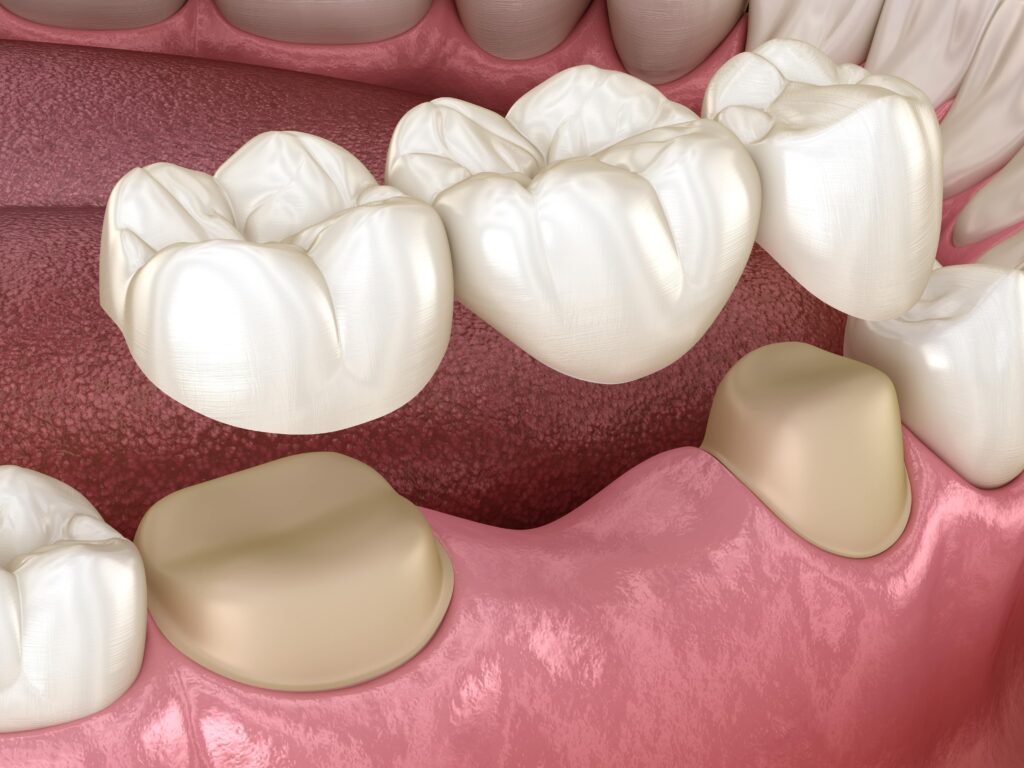Crown and Bridge Work
Crown and Bridge Work
Crowns— artificial covers (sometimes called “caps”) that replace the entire visible surface of a tooth above the gum line. Fabricated of metal, porcelain fused to metal, or all-ceramic (porcelain), crowns are cemented to a prepared tooth with intact roots. They are often needed after a root canal procedure, or to repair fractured, broken or misshapen teeth
Fixed Bridges — this tooth-replacement method uses the existing, healthy teeth (called abutment teeth) on either side of a gap to support one or more artificial teeth. A series of linked crowns is fabricated as a single unit, which is then attached to the prepared abutment teeth. These work like a roadway-bridge foundation to hold up the crowns for the missing teeth in between. Bridges are a time-tested tooth-replacement method, but require special attention to cleaning, and potentially compromise the structure of the otherwise healthy abutment teeth.

Dentistry is an art as well as a science; dental crowns offer a perfect example of this. A dental crown or “cap” is a covering that fits over a damaged, decayed or unattractive tooth. It can even replace a tooth entirely as part of dental bridgework.
A crown completely covers a tooth above the gum line. This is in contrast to a dental veneer, which only covers a tooth’s front surface and needs natural tooth structure to support it. Therefore, if a tooth is missing a significant amount of structure above the gum line, a crown would be the restoration of choice.
Crowns strengthen damaged teeth, allowing them to function normally again. When crafted from today’s high-tech porcelains (dental ceramics), crowns are virtually indistinguishable from natural teeth. They can even be designed to improve upon a tooth’s original appearance.
Creating a Bridge
Crowns and bridgework require the same conscientious care as your natural teeth. Be sure to brush and floss between all of your teeth — restored and natural — every day to reduce the buildup of dental plaque. When you have crowns, it is even more important to maintain your regular schedule of cleanings here at the dental office. Avoid using your teeth as tools (to open packages, for example). If you have a grinding habit, wearing a nightguard would be a good idea to protect your teeth and your investment.
When are crowns or bridgework needed?
- Crowns: This versatile dental restoration is helpful in various situations. Dentists often use crowns after a root canal to stabilize the large filling left behind in the tooth. While the filling material is strong and durable, a dental crown is an added layer of protection to the tooth’s natural structure. Crowns can also fall under the cosmetic facet of dentistry, improving the appearance of a misshapen or discolored tooth to better fit into your smile. In situations where a tooth is worn or damaged, a dental crown can restore its biting surface, improving the efficiency of eating and chewing.
- Bridgework: A dental bridge can replace a missing tooth by “bridging” the gap between the two healthy teeth on either side. Bridgework can be either removable or permanent, depending on your preference and your situation. Removable bridges use metal clasps on either side of a prosthetic tooth to hold the bridgework in place. A permanent bridge uses dental crowns on either side, anchoring onto the healthy teeth and remaining permanently in the mouth. Unlike other tooth replacement options like dental implants, bridges lie above the gumline and rest on its surface.
What Are the Benefits of Dental Bridges
Bridges can:
- Restore your smile
- Restore the ability to properly chew and speak
- Maintain the shape of your face
- Distribute the forces in your bite properly by replacing missing teeth
- Prevent remaining teeth from drifting out of position
What is post and core?
Post and core is a dental restoration treatment that’s sometimes performed after a root canal.
When a significant portion of a tooth’s structure is removed, a post and core can help keep a dental crown in place. Dental crowns are put on top of teeth, to protect them from further damage or infection.
During a root canal procedure, a portion of your tooth and your pulp-filled cavity in the root of your tooth is removed. The pulp contains:
- blood vessels
- Nerves
- Connective tissue
In some instances, there may not be enough tooth left intact to return it to typical function.
When this occurs, a post and core can be performed to keep a dental crown in place, and to reconstruct, or build the missing portions of your tooth.
When is post and core used?
During a post and core procedure, the root canal must be devoid of its original pulp-filled cavity or chamber (the root is still present).
The post goes inside the canal, which is sealed during the root canal procedure. For that reason, this post and core is performed after a root canal.
Roark only recommends a post and core procedure when more than 50 percent of your tooth’s original structure is removed. In these instances, the post helps mechanically retain the dental crown and core.
The post and core procedure should not be performed if there is enough remaining tooth structure available to hold a crown in place.
